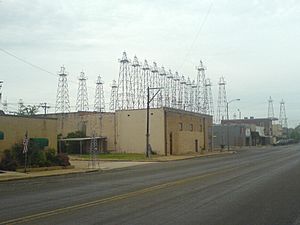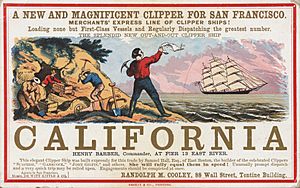Boomtown facts for kids
A boomtown is a place that has very quick population and economic growth. Boomtowns are usually mining towns where an important mineral resource such as gold, silver, or petroleum has been found. It can happen, for example in a gold rush. Gold rush towns usually shrink and disappear after the gold is dug up. They become ghost towns.
The word can also be used for places that grow for other reasons. This can be the town being near a major city, in a nice climate or near a popular attraction.
First boomtowns
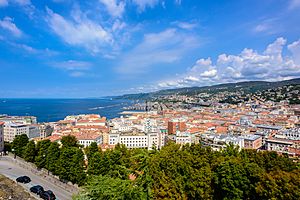
Early boomtowns, such as Leeds, Liverpool, and Manchester, experienced a dramatic surge in population and economic activity during the Industrial Revolution at the turn of the 19th century. In pre-industrial England these towns had been relative backwaters, compared to the more important market towns of Bristol, Norwich, and York, but they soon became major urban and industrial centres. Although these boomtowns did not directly owe their sudden growth to the discovery of a local natural resource, the factories were set up there to take advantage of the excellent Midlands infrastructure and the availability of large seams of cheap coal for fuel.
Another typical boom town is Trieste in Italy. In the 19th century the free port and the opening of the Suez Canal began an extremely strong economic development. At the beginning of the First World War, the former fishing village with a deep-water port, which used to be small but geographically centrally located, was the third largest city of the Habsburg monarchy. Due to the many new borders, World War II and the Cold War, the city was completely isolated, abandoned and shrunk for a long time. The handling of goods in the port and property prices fell sharply. Only when the surrounding countries joined the EU did Trieste return to the economic center of Europe.
In the mid-19th century, boomtowns were based on natural resources began to proliferate as companies and individuals discovered new mining prospects across the world. The California Gold Rush of the Western United States stimulated numerous boomtowns in that period, as settlements seemed to spring up overnight in the river valleys, mountains, and deserts around what was thought to be valuable gold mining country. In the late 19th and early 20th centuries, boomtowns called mill towns would quickly arise due to sudden expansions in the timber industry; they tended to last the decade or so it took to clearcut nearby forests. Modern-day examples of resource-generated boomtowns include Fort McMurray in Canada, as the extraction of nearby oilsands requires a vast number of workers, and Johannesburg in South Africa, based on the gold and diamond trade.
Examples
Australia
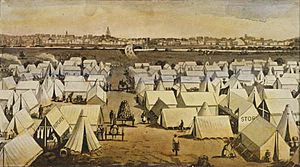
- Ararat (1850s Victorian Gold Rush)
- Ballarat (1850s-1880s Victorian Gold Rush)
- Bathurst (1850s Australian gold rushes)
- Bendigo (1850s-1880s Victorian Gold Rush)
- Broken Hill (1880s silver-lead-zinc boom)
- Castlemaine (1850s Victorian Gold Rush)
- Charters Towers (1870s gold rush)
- Gold Coast (1980s-2000s due to internal Australian migration trends)
- Kalgoorlie (1890s gold rush)
- Melbourne (1850s-1880s Victorian Gold Rush and associated speculative "land boom")
- Perth
Brazil
- Altamira, Pará
- Balsas, Maranhão
- Brasília, Federal District, development of capital
- Goiânia, Goiás
- Laranjal do Jari, Amapá
- Luís Eduardo Magalhães, Bahia
- Ouro Preto, Minas Gerais (Ouro Preto Gold Rush)
- Palmas, Tocantins
- Parauapebas, Pará
- Rondonópolis, Mato Grosso
- Serra Pelada District, Curionópolis, Pará (Serra Pelada Gold Rush)
- Sinop, Mato Grosso
- Sorriso, Mato Grosso
- Tucuruí, Pará
- São Paulo, São Paulo
Canada
- Calgary, Alberta (during the 1970s oil boom in the province of Alberta)
- Dawson City, Yukon (Klondike Gold Rush)
- Edmonton, Alberta
- Elliot Lake, Ontario
- Estevan, Saskatchewan
- Faro, Yukon
- Fisherville, British Columbia (gold rush boom town of 1864-1865)
- Barkerville, British Columbia
- Fort McMurray, Alberta, oil
- Greater Sudbury, Ontario
- Halifax, Nova Scotia, as a port city during the First World War, prior to The Halifax Explosion
- Kirkland Lake, Ontario
- Oil Springs, Ontario
- Petrolia, Ontario
- Sept-Îles, a city in the Côte-Nord region of eastern Québec, Canada
- Shawinigan, Quebec
- Sydney, Nova Scotia
- Yellowknife, Northwest Territory
United Kingdom
- Aberdeen, North Sea oil boom, known as the "oil capital of Europe"
- Barrow-in-Furness, late 19th and early 20th centuries as the world's largest steelworks and major shipyard
- Belfast, Northern Ireland, fastest-growing settlement in the British Isles in the 19th century due to industry and its port
- Jarrow,
- Leeds,
- Liverpool, industry and shipping, emigrants
- Manchester, rapid economic growth in the early 19th century
- Preston, Lancashire, the boomtown of the Industrial Revolution
- Winster, Derbyshire, England (17th century lead mining community)
United States
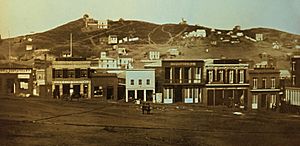
- Anderson, Indiana, automotive industry
- Atlanta, Georgia (rapidly rebuilt and became a commercial center in the years following the Civil War)
- Atlantic City, New Jersey resort boomtown, 1870-1940
- Basic City, Virginia, railroads and mining, 1880s-1900s
- Beaumont, Texas, oil
- Belleville, California, gold-mining boomtown, 1860-1870
- Birmingham, Alabama, coal and iron ore, 1880s
- Bodie, California
- Borger, Texas
- Buffalo, New York, shipping via Erie Canal, steel production, 1825-1890
- Burkburnett, Texas
- Butte, Montana, copper and other resources
- Caldwell, Kansas
- Central City, Colorado
- Chicago, Illinois, railroads, commodity resources, business
- Cincinnati, Ohio, trade, shipping
- Colstrip, Montana
- Columbia, California
- Cripple Creek, Colorado
- Deadwood, South Dakota
- Denver, Colorado
- Desdemona, Texas
- Detroit, Michigan rise of the automobile industry, 1910-1950
- Dodge City, Kansas
- El Paso, Texas
- Elkhart, Indiana recreational vehicle and manufactured housing industry
- Ellsworth, Kansas
- Endicott, New York (shoe manufacturing boomtown, 1900s-1920s)
- Fairbanks, Alaska, during the Klondike Gold Rush and the building of the Trans-Alaska Pipeline
- Gary, Indiana, steel
- Gillette, Wyoming
- Goldfield, Nevada
- Graysonia, Arkansas
- Guthrie, Oklahoma, oil
- Hancock, Michigan
- Harrisburg, Illinois
- Holyoke, Massachusetts, paper, silk and wool textiles, 1860-1914
- Houghton, Michigan
- Humble, Texas
- Idaho City, Idaho, gold rush, 1860s
- Jeffrey City, Wyoming
- Kilgore, Texas
- La Paz, Arizona, gold-mining boomtown, 1862-1864
- Leadville, Colorado
- Minneapolis, Minnesota Lumber Industry 1852-1880
- Newport, Wisconsin, sprang up because of a bridge expected to be built across the Wisconsin River there
- New Bedford, Massachusetts, whaling
- Nome, Alaska
- Odessa, Texas, oil
- Pittsburgh, Pennsylvania, steel, trade
- Pocatello, Idaho, railroad, 1870s-1920s
- Richland, Washington
- Rochester, New York, starting in the 1820s, with the opening of the Erie Canal
- Sacramento, California
- St. Joseph, Florida
- San Francisco, California, US settlement after winning Mexican War
- Salt Lake City, Utah
- San Luis, Arizona
- Seattle, Washington, became a prosperous port city during the Klondike Gold Rush in 1897 subsequently after its great fire which also brought in an influx of jobs and newcomers
- Sioux City, Iowa
- Tombstone, Arizona
- Texarkana, TX/AR
- Virginia City, Nevada, silver-mining boomtown, 1860s
- Wenatchee, Washington and other towns in the area are currently undergoing massive electrical infrastructure growth to support bitcoin mining due to the cheap local electricity
- Wentzville, Missouri
- Williston, North Dakota, oil
Others
- Batam, Indonesia, free trade
- Carbonia, Italy
- Dubai, UAE, oil
- Dublin, Ireland
- Dunedin, New Zealand due to the 1860s Gold Rush
- Bangalore, India - due to outsourcing of call centers and the IT industry
- Hyderabad, India - due to outsourcing of call centers and the IT industry
- New Town, Kolkata - due to growth of IT industry
- Johannesburg, South Africa
- Karachi, Pakistan
- Kimberley, South Africa, diamonds and gold
- Leipzig, Germany
- Monterrey, Nuevo León, Mexico, industrialization due to metallurgic and brewing industries and their related supply chains
- Nizhnevartovsk, Russia, oil
- Novosibirsk, Russia, planned development as a scientific and industrial center; hosted evacuated population and industry during World War II
- Roubaix, France
- Shenzhen, China


